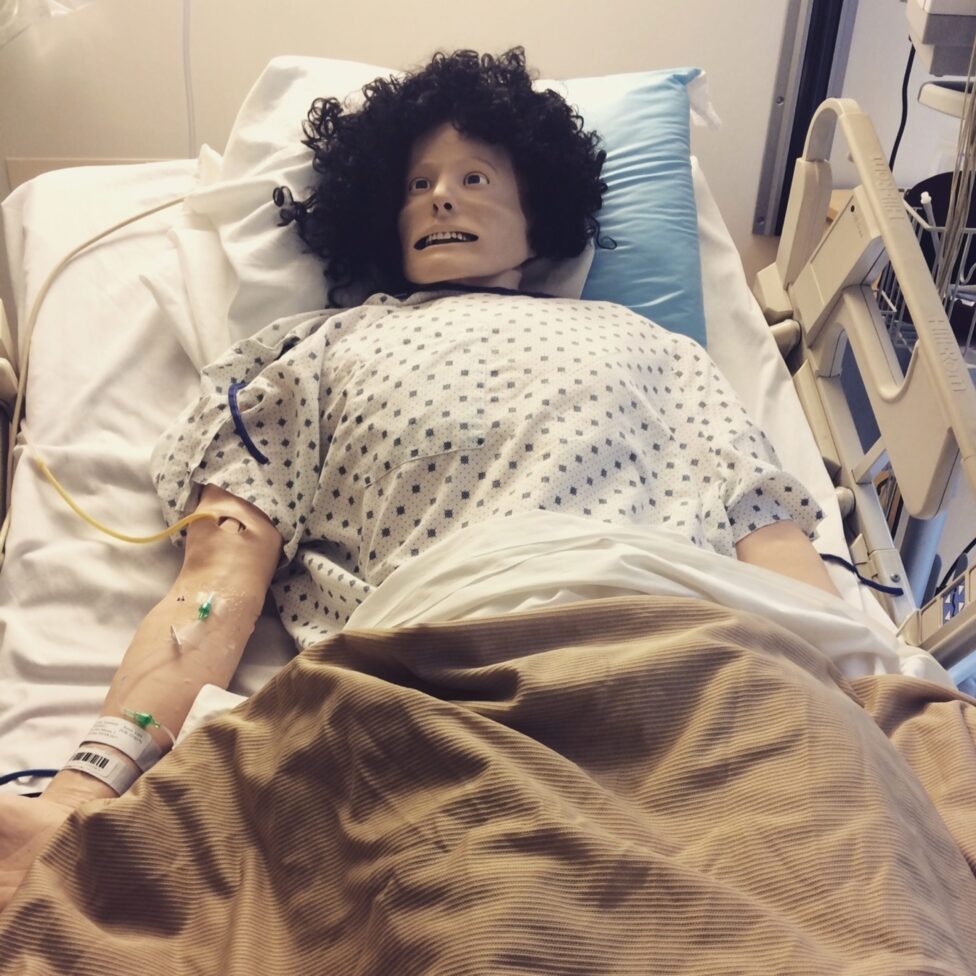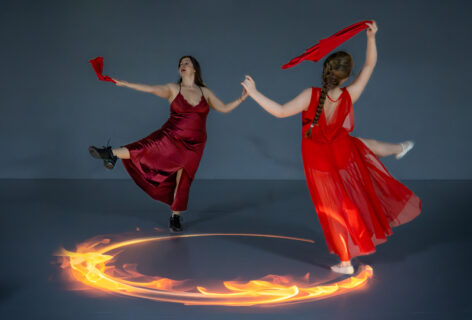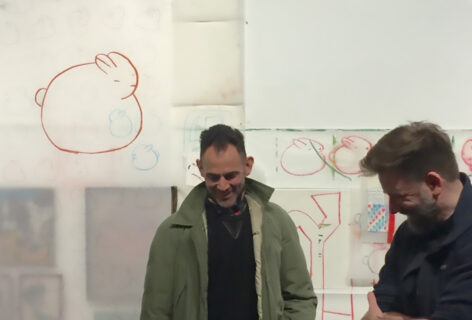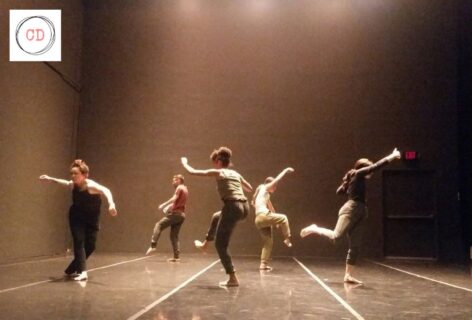Question: How does your upcoming piece relate to your work as a new nurse?
Answer: I met these mannequins and robots in nursing school and they quickly became the focus of my choreographic work. #mymannykinfriends (working title) is an evening length performance utilizing text, choreography, live original music and recorded robotic voices. It is the first performance in a trilogy project. The work is anchored by the resemblance of a medical mannequin who plays multiple characters. The characters share stories of near death experiences, pre-death visualizations, and transitions into the afterworld. The mannequins that I met in medical training blink, breathe, talk and even scream. Their lungs expand, their heart rhythms change, you can inject fluids into them or pull fluids out of them. The lines of reality here are quite blurry; a frequency I’m familiar with in my own liminal existence. I remember taking a tour of the nursing school and feeling my whole body halt when I walked into the mannequin filled simulation room. I was sure there were ghosts in the room — spirits. I recall tracing the horizon of the other visitors’ eyes to glean any other responses and saw nothing. The mannequins were on, they were breathing and blinking in the periphery. Since I was a child, I’ve been someone who can audibly and visually engage with spirits. It shocked me that the sensation I get in my body when spirits enter a room was the same sensation I had with these mannequins. Sound exits, and energy becomes stagnant. My body enters a heightened sensorial state. The similarity here lies in connecting to another plane of existence, bridging multiple forms of reality. I think we all have access to this other plane if we hone it, though we may not all welcome it. Perhaps I went to nursing school to meet these robot-mannequin beings. I’ve found my kindred people!
Question: How did interacting with the mannequins during your nurse training serve you now?
Answer: In nursing, we take these medical robots through the life cycle as a way to prepare for working with flesh bodies. I birthed crying mechanical baby robots, gave CPR to robots who lost a pulse, and practiced end of life and post mortem care with a crying actor playing the role of the forlorn mother. I became enamored with these kindred in-between beings. The mannequins served as a shiny reflective object for my in-between body, as well as a site for object relations to help me cope while working on a daily trauma unit. I’ve been in Eastern Medicine for 18-years, practicing as a massage therapist, healer, and ritual guide. The mannequins were a support system while I navigated the culture shock of Western Medicine. The mannequins have helped foster a softer place to explore the layers of brutality around death and dying that are sometimes embedded within the Northern American hospital system. The mannequins have helped me as I research death rituals within my indigenous bloodline. #mymannykinfriends is a container to hold all of the complexities of my spiritual practice of connecting to the spirit realm and the spirits that I meet while ushering folks into the next life in the hospital. I have fallen in love with #mymannykinfriends as a medium and teacher.
Question: As you describe it, the mannequin seems like a very animate body. Aren’t we all a bit mannequin?
Answer: My body is the container in which I’m making my work from. The information I take in daily affects my work, but it’s deeply embedded and woven. I am a mixed-race transgender dancer and choreographer who’s not so invested in naming identities to clarify or forward my work. We seem to still be in a moment where marginalized bodies are pushing to create space in society against the current state of emergency, and this bodes true in performance work also. I suppose the goal is for institutions and audiences to wake up, but I find it mostly exhausting to name as I’m not interested in how this validifies my work; it just is.

Photo: devynn emory
Question: So, the mannequins are interesting transition planes between real and unreal, alive and dead?
Answer: Exactly. I relate to this…as a trans person, a mixed race person, as a person who has constant access to this plane and others. This in-between space is my home space and I’m quite sensitive to the embodiment that feels vibrant in this way. The mannequins have a high frequency of slippery-ness; are they a person sitting next to me or an object? I walk into a room and can hear/see/communicate with other planes of experience. Folks often come forward in my healing practices and in the hospital, I bear witness to patients’ as they leave this life and transition to another. I believe we are all on a spectrum of moving towards a death of sorts each day. I’m interested in embracing this truth as a culture.
Question: You were saying that, as part of the training, you had to talk to the robot’s relative which was an actor? It sounds like the robots are representations of real human physical reactions, emotions and pain. You get attached to them, and are performing the role of the caregiver. Does it feel like simulation or does it get pretty real?
Answer: The simulation rooms were energetically charged. The pressure was immense, in a way quite similar to life; the mannequin and the actors were interruptive, angry, and emotional family members. The actors were there to simulate reality. There’s nothing that can ever really prepare you for real death and dying. Losing a patient I’ve spent months with and the wide range of responses from the family and how the institution responds – nothing can really prepare you for that. Each death comes with a wide variety of challenges. It’s never something to get used to. In simulation, the robot was always in distress crying out something like, “What’s happening to me, I can’t breathe!” I would get very invested and my classmates would laugh. Perhaps I related more to the mannequins than I did to my classmates.
Question: You were queering up the inanimate body of the mannequin. Why do you think the bond became so strong?
Answer: I quickly learned that you could swap around their genitals. I would secretly swap them in a teaching scenario to bring up the possibility and conversation of having transgender patients. This became a focus of nursing school for me and I became the President of the LGBTQ+ Nursing society. I organized workshops, lectures, panels and a conference on transgender medicine and the overlap in End of Life care, HIV, pediatrics and birth work.
Question: We are all inside a constant dance of illness and disability, but not everyone is aware of it. Ableist people see themselves as separate from the sick. And the same happens with the passage from life to death. It’s seen as a definite event, but there is a transition.
Answer: Outside of the hospital there seems to be a binary of able or dis-abled. Well or sick. Inside of the hospital setting, our version of a “stable” patient or “well” patient is one that’s dying but perhaps not in the next 6 months. We are all on a spectrum of illness. We live in an ableist society (I’m speaking to North America where I was born and raised) and this point is an important one. I believe most bodies are confronted by an illness dichotomy or an illness threat every day. As a society we have been trained to look away from our bodies, especially a slowly decaying body. Some of us are actively engaged in our bodies and some of us don’t have a choice not to be.
Question: How does your mixed ethnicity affect your body and spirit and do you bring this knowledge to the performance you make?
Answer: For me, my internal structure of being part Indigenous part colonizer feels like I’m in an argument with myself. If I were a structure, I’d be a bridge. I went into this project researching Indigenous death rituals, hoping it could be a way to reconnect with my estranged blood family. The rekindling and discussion of internalized racism and trauma will take a lot longer than I imagined; as it should. Ritual has always been a big part of my spiritual practice and has woven it’s way into my work. There is a kind of ritual care I provide for the dying, and certainly for the expired; this is the term used in hospitals that I’m still unpacking. There’s a lot about who I am that I bring into the care of my patients including my bloodline of Indigeneity, and often it’s butting up against the sterility of a western, Northern American hospital setting. That being said, I have been very humbled and privileged to be exposed to so many different religions, cultures, ethnicities, and people who bring their own traditions into the hospital setting whether you have time for it or not. It feels important to allow this to be in conversation with the work. Dying is an experience we are all going through.
Question: Will the audience get to meet the mannequin?
Answer: The mannequin serves as a placeholder to talk about death and dying before it happens. Death is often approached in a crisis. But it is actually not so dis-similar to birth, sex, or joy. A transition. A shift in the texture of existence. The history of my people includes a large massacre of our culture. Death is not something we forget, despite how America tries to hide it. It doesn’t include relief by way of reuniting with God, because God/Goddess/Goddex is in the elements; the land, the water, the air….and we tend to goddex daily. This doesn’t mean that death isn’t mournful or that it can’t happen tragically. I’ve experienced too much loss of my transgender siblings and friends who die from the disease of substance misuse, or living grief and disconnect. I wonder if we bring death and dying into our everyday practices and discussions, if it could be less of a forbidden and shocking subject when it arrives? I’d like to break open the forbidden. I have no option as I’m around death daily. It has already broken open. #mtmannykinfriends is an invitation for others to engage in this topic with me. The mannequin also serves the work as a shiny object, one that reflects back onto this transgender body, this bi-racial body, this body who can commune with the other side. They help me/us process it all by implementing my/our body.
Question: That’s a great thing to end with.
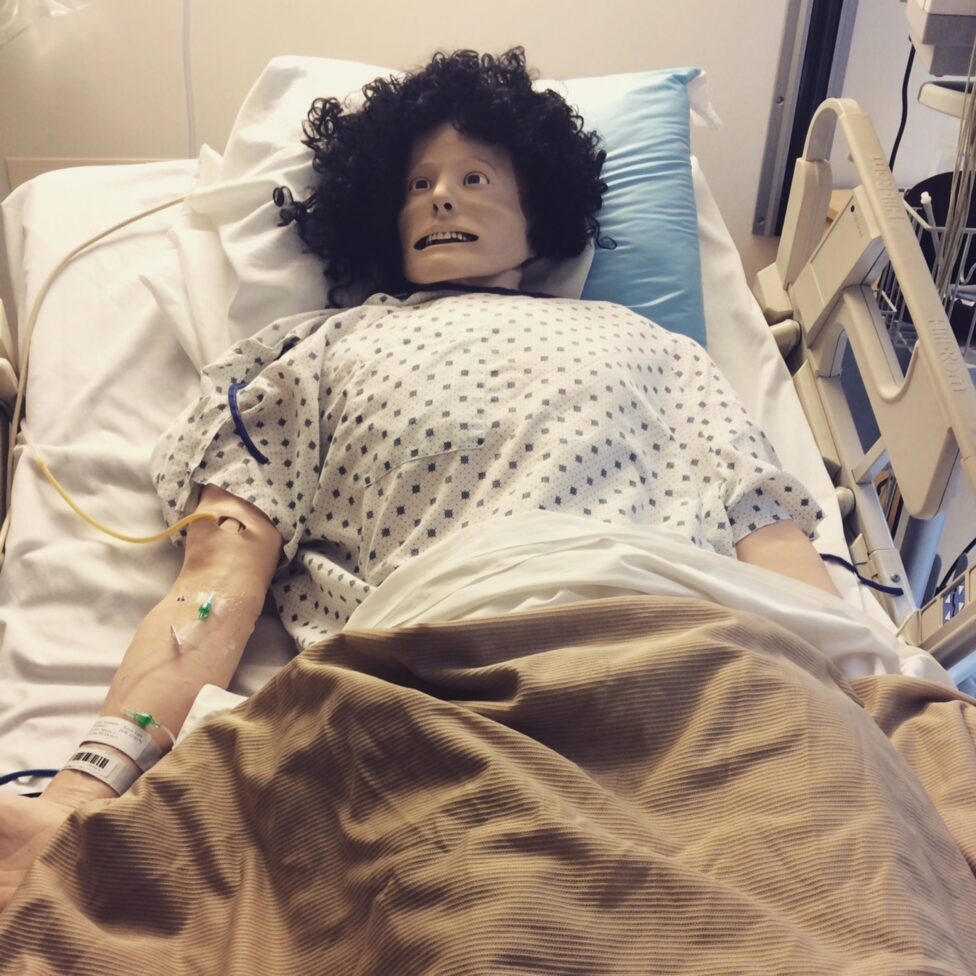
Photo: devynn emory
The first show of devynn’s #mymannykinfriends series will be at Danspace Project in April, 2020

